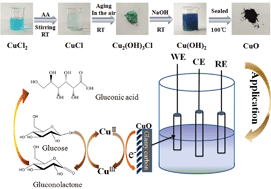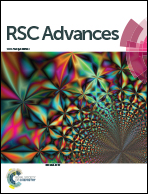Phase transformation-controlled synthesis of CuO nanostructures and their application as an improved material in a carbon-based modified electrode†
Abstract
Column-shaped CuO nanorods have been synthesized by a two-step “precursor formation-crystallization” process using a hydrothermal method with advantages of being template- and surfactant-free. The regular particle morphology of the as-prepared material was explored to be produced through a good transformation process coupled with a series of phase changes from CuCl, to Cu2(OH)3Cl, to Cu(OH)2, which rely on heat by using NaOH and n-butylamine solution in a sealed vessel, and finally to CuO. Scanning electron microscopy (SEM), energy-dispersive X-ray spectrometry (EDX), X-ray diffraction (XRD), and Raman spectroscopy were employed to characterize the morphology and structures of our samples. The as-prepared CuO nanostructures have been employed to modify a glassy carbon electrode for nonenzymatic glucose oxidation. Compared with the bare glassy carbon electrode, the CuO modified electrode exhibits satisfactory performance with an apparent rate constant of κ as high as 231.0 M−1 s−1 due to its high specific surface area and especially good electron delivery capability of the CuO nanorods.


 Please wait while we load your content...
Please wait while we load your content...